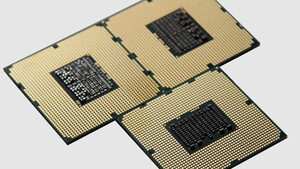During
execution, current x86 processors employ a few extra decoding steps to split most instructions into smaller pieces called micro-operations. These are then handed to a
control unit that buffers and schedules them in compliance with x86-semantics so that they can be executed, partly in parallel, by one of several (more or less specialized)
execution units. These modern x86 designs are thus
pipelined,
superscalar, and also capable of
out of order and
speculative execution (via
branch prediction,
register renaming, and
memory dependence prediction), which means they may execute multiple (partial or complete) x86 instructions simultaneously, and not necessarily in the same order as given in the instruction stream.
[13] Intel's and AMD's (starting from
AMD Zen) CPUs are also capable of
simultaneous multithreading with two
threads per
core (
Xeon Phi has four threads per core) and in case of Intel
transactional memory (
TSX).
When introduced, in the mid-1990s, this method was sometimes referred to as a "RISC core" or as "RISC translation", partly for marketing reasons, but also because these micro-operations share some properties with certain types of RISC instructions. However,
traditional microcode (used since the 1950s) also inherently shares many of the same properties; the new method differs mainly in that the translation to micro-operations now occurs asynchronously. Not having to synchronize the execution units with the decode steps opens up possibilities for more analysis of the (buffered) code stream, and therefore permits detection of operations that can be performed in parallel, simultaneously feeding more than one execution unit.
The latest processors also do the opposite when appropriate; they combine certain x86 sequences (such as a compare followed by a conditional jump) into a more complex micro-op which fits the execution model better and thus can be executed faster or with less machine resources involved.



